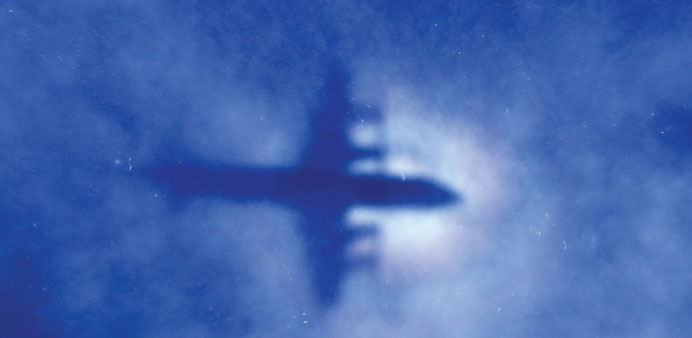The shadow of a Royal New Zealand Air Force P3 Orion maritime search aircraft seen on low-level clouds as it flies over the southern Indian Ocean looking for missing Malaysian Airlines flight MH370 in this March 31, 2014 file photo. No trace has been found of the Boeing 777 aircraft, which disappeared a year ago this week carrying 239 passengers and crew, in what has become one of the greatest mysteries in aviation history.
By Updesh Kapur/Doha
Sunday will mark 12 months since the mysterious disappearance of a commercial aircraft on a routine scheduled flight across Asia.
A Boeing 777 aircraft with 239 passengers and crew onboard went off the radar screens an hour into its flight from Kuala Lumpur to Beijing in the early hours of March 8.
The story of Malaysia Airlines flight MH370 has consumed the global media ever since.
A year on with no trace of its whereabouts nor a shed of evidence about what happened to the aircraft has made this a mystery of all mysteries in aviation history.
Many safety experts believe the flight was deliberately diverted, with the transponder that transmits a plane’s identity turned off to avoid detection.
Yet conspiracy theories have been doing the rounds for months. The aircraft evaded radar to land safely at a remote Asian airport with all those onboard said to be in a safe hideout; hijackers took control of the aircraft and landed at any one of 600 possible airstrips in the region.
The aircraft was seized to obtain classified information from Chinese passengers employed by a US firm that develops new technology; the captain deliberately crashed the aircraft into the sea on a suicide mission; the plane was intercepted by Western military jets and shot down; onboard communication systems were deliberately switched off, pilots apprehended and the aircraft forced on autopilot to change course south towards the Indian Ocean before crashing into its resting place. The theories continue to mount.
Investigators are convinced the aircraft is lying on the bottom of the ocean thousands of miles from its last known appearance, according to whatever data analysts have been able to decipher. With no floating wreckage found at all, the suggestion is the aircraft is virtually intact on the seabed, fuelling thought that it was carefully glided onto the sea surface to minimise possible structural damage before sinking to the bottom of the ocean. An international coalition of search and salvage teams has been unsuccessful in the weeks and months since the aircraft’s disappearance to find any evidence at all.
Deep sea search teams are continuing their efforts. But combing a sprawling area of tens of thousands of square kilometres as deep as 6,000 metres remains a huge challenge. It’s the ongoing pressure, the need to know where the aircraft is and what happened that will only put closure to the mystery.
Ships with specialists and equipment capable of searching depths that regularly exceed 4,000 metres are working around the clock, ticking off sections of the sea floor that have been searched. Unmanned submarines are also involved in the search efforts, able to meander their way through difficult underwater terrain including steep mountain slopes that other equipment is unable to do so.
The clock is ticking as efforts are ramped up ahead of the southern winter when adverse weather conditions prevail from around May onwards.
Following a six-month probe of flight data using a unique mathematical technique, a Boeing 777 British pilot believes the aircraft is lying on the bottom of the ocean at least 100 nautical miles from where Australian authorities have been searching up until now in the Indian Ocean, west of Australia’s coastline.
He believes the captain of MH370 steered the aircraft on an “emotional farewell” fly-past with unusual twists and turns over his homeland of Penang Island off the western Malaysian coastline. According to the investigative pilot’s calculations which are being described as credible and are now being investigated by Australian authorities, based on signals from an Inmarsat satellite, the plane flew along the Malaysia Thailand border going in and out of both countries’ airspace several times to cause confusion between air traffic controllers. The aircraft was manoeuvred south towards the Indian Ocean flying for hours on autopilot before it crash landed on the water and sank intact that explains why no wreckage has ever been found. It is reported that the plane was depressurised to force those onboard into an unconscious state.
The latest theory comes as Australia’s transport minister announced the country will, alongside Indonesia and Malaysia, lead a trial of an enhanced method of aircraft tracking over remote oceans.
The new method would enable planes to be tracked every 15 minutes, rather than the previous rate of 30 to 40 minutes, which begs the question why such monitoring hasn’t been carried out with greater frequency to date.
The trial is expected to use satellite-based positioning technology already on board 90% of long-haul aircraft that transmits the plane’s current position and its next two planned positions. The trial will boost the frequency with which planes automatically report their position, allowing air traffic controllers to better track them. Regardless, whatever the scientific breakthrough, it is the comfort needed by families of those onboard to know exactly what happened on that tragic night. And of course the aviation industry worldwide needs to understand to better improve its safety and security processes. In January, the Malaysian government declared with the “heaviest heart and deepest sorrow” the greatest mystery in aviation history was an accident. This definition of the disappearance has caused consternation among families fearing the search efforts have all but stopped.
But the declaration is a necessary legal step to enable relatives of the victims to begin insurance compensation claims from the airline in accordance with international protocol, while search teams continue trawling through difficult waters.
There will be poignant scenes coming out of Beijing and Kuala Lumpur on Sunday on the first anniversary of the disappearance of MH370.
Yet against the backdrop of the incident and the shooting down of another Malaysia Airlines aircraft last July, a Boeing 777 over the Ukraine/Russia border en route from Amsterdam to the Malaysian capital, 2015 is the year of radical overhaul for the ill-fated airline.
Malaysia Airlines will cut seat capacity, review its fleet and routes and re-negotiate staff and service contracts as part of a major restructuring programme that could see one-third of its 14,000 workforce lose their jobs.
New owner Khazanah Nasional Berhad aims to have loss-making Malaysia Airlines emerge as a new company on July 1.
It is the first announcement by the government’s strategic investment firm since it took control of the troubled carrier in December following the two tragedies to hit Malaysia Airlines.
Khazanah has outlined a 12-point recovery plan targeting profitability by 2017 and re-listing on the Bursa Malaysia stock market in Kuala Lumpur by 2020. The targeted turnaround will include cutting seat capacity by 10% across its network and focus on more profitable domestic and regional routes. Under careful evaluation are the sustainability of flights from Kuala Lumpur to Europe, including Paris and London, operated with the Airbus A380 superjumbo. The routes could be threatened if they failed to contribute to group profitability. The future of the A380s in MAS’s fleet is also being questioned. The airline has also appointed a new CEO, Christoph Mueller, the former boss of Aer Lingus having been lauded for improving the Irish carrier’s financial performance over the years.
Come this summer, Malaysia Airlines is expected to emerge as a new company. But it is a tall order to resurrect a brand from the clouds of two tragedies that will forever be linked to Malaysia Airlines.
- Updesh Kapur is a PR & communications professional, columnist, aviation, hospitality and travel analyst. He can be followed on twitter @updeshkapur



